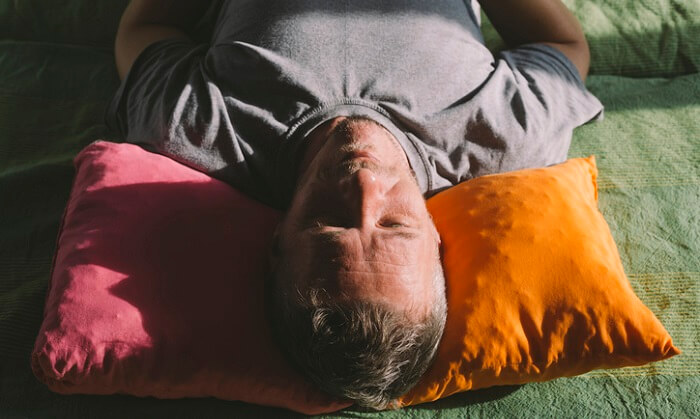After you hit about age 35, lung function starts to gradually decline. This means that as you age, your diaphragm muscles get weaker, your lung tissues lose elasticity, and your rib cage gets smaller. All of these add up to decreased lung capacity.1 So if you’ve been experiencing shortness of breath and feel like your respiratory health isn’t what it once was, then you aren’t alone.
Aside from normal aging, some people have conditions that affect their lung health and make it exceptionally difficult to breathe normally. Diseases like chronic obstructive pulmonary disease (COPD) and asthma are two such examples.
Whether you are looking to stay healthy, are dealing with shortness of breath with normal aging, or have a chronic condition like COPD or asthma, there are many things you can do to improve your lung function.
Deep breathing exercises are one effective way to improve your respiratory health. A lot of us unknowingly breathe quite shallowly and inefficiently, using only our chest. But retraining our bodies to breathe deeply with the use of simple breathing practices can have tremendous benefits.
Why practice deep breathing?
We go to the gym to work out so that we can strengthen our bodies and improve our fitness. Breathing exercises are simply a way to work out our respiratory health in particular.
By doing deep breathing exercises, we train ourselves to breathe better and strengthen our respiratory muscles so that we can breathe deeper and more fully. This can bring about many positive changes in the body.

Deep breathing practices have been shown to help improve respiratory function in healthy people.2 3 4 5 These exercises can help to strengthen breathing muscles, get rid of stale air in the lungs, increase oxygen levels, and increase lung capacity.6
Deep breathing exercises also have other wide-ranging benefits in the body such as combating stress, increasing physical performance and fitness for athletes, and helping improve low back pain.7 8 9
Health conditions that benefit from deep breathing
If you have a respiratory condition or disease, deep breathing exercises can be of particular benefit.
Some of the health conditions known to benefit from breathing exercises include:
- Chronic obstructive pulmonary disease (COPD)
- Asthma
- Chronic bronchitis
- Emphysema6 10 11 12 13 14
If you have one of these conditions, breathing exercises can be an effective complementary therapy to your treatment plan. For example, diaphragmatic breathing and pursed-lip breathing are recommended for improving symptoms of COPD.10
Improve respiratory health with these 5 deep breathing exercises
Whether you feel like your lung capacity isn’t what it used to be, have a chronic lung disease, or just want to keep your body in top shape, give breathing exercises a try. They are simple, easy to fit into your daily routine, and very effective.
There are many different ways to practice deep breathing. To get started, give these 5 breathing practices a try.
1. Diaphragmatic breathing

Diaphragmatic breathing is also known as belly breathing. The idea is to focus on using your diaphragm muscle to breathe, so that you breathe with your belly rather than just with your chest. By doing that, you will get a much deeper inhale and exhale.
Diaphragmatic breathing is recommended for healthy individuals as well as for people with lung problems like asthma, emphysema, chronic bronchitis, and COPD.6 10 11 15
How to do it:
- Sit up straight or lay flat on your back. Place one hand on your belly and one on your chest.
- Inhale deeply and slowly through your nose, focusing on using your belly to breathe in.
- Use your hands to feel the air move in through your body. You should feel your abdomen and lower ribs rise. Your chest should stay relatively still.
- Exhale deeply and slowly, using your diaphragm and abdominal muscles to let the air out. Again, you should feel the hand on your stomach move, not the one on your chest.
- Continue breathing in and out this way, trying to use your diaphragm more and more each time you inhale and exhale. Keep your chest still.
Note that this exercise can be tiring at first. We recommend starting with 5-10 minutes at a time, a few times per day.6 15
2. Pursed-lip breathing
Another strategy that can help strengthen your breathing muscles is pursed-lip breathing. With this exercise, you use pursed lips to slow down your exhale. It is very effective in relieving shortness of breath.16
Along with diaphragmatic breathing, pursed-lip breathing is one of the top recommended breathing exercises for people with lung diseases like asthma or COPD.6 10 11
How to do it:
- Find a relaxed position, either lying down or seated upright.
- Inhale through your nose. You don’t have to take a slow or extra-deep breath. A normal breath in will do.
- On your exhale, breathe out slowly through your mouth through pursed lips.
- Continue breathing this way, in normally through your nose and out slowly through pursed lips.
- On each cycle, your out breath should be twice as long as your in breath. Two seconds in and 4 seconds out is a good place to start if counting helps.
- Do not force air out, and breathe in a way that is relaxed and easy.
- Practice several times per day.
- You can use this technique during any activity where you find yourself short of breath, such as climbing stairs.6 16
3. Paced breathing

Counting as you breathe can help regulate your inhales and exhales and maintain a regular rhythm of breathing. It can help increase the length of your inhalation and exhalation, ultimately increasing lung capacity as you practice.10 Paced breathing is also a great way to relax and de-stress.
One version of paced breathing is called “4-7-8 breathing.”
How to do it:
- Choose a time of day where you can be completely relaxed and peaceful. Before bed is a good time.
- Get in a comfortable position, either sitting with your back upright or lying on your back. Relax your neck and shoulders.
- Breathe in for 4 seconds.
- Hold your breath there for 7 seconds.
- Exhale slowly and smoothly for a count of 8 seconds.
- Repeat, moving through the 4-second inhale, 7-second hold, 8-second exhale cycle about four times total.
- Do this once or twice a day.
4. Alternate nostril breathing
This breathing practice is common in yoga practices. With this exercise, you breathe in through one nostril and out through the other.
Alternate nostril breathing can help improve lung capacity and overall lung function.8 It is also very relaxing.
How to do it:
- Choose a time of day you can be relaxed.
- Sit in a comfortable position.
- Rest your left hand in your lap. Lift your right hand to your nose.
- With your right thumb, close your right nostril.
- Inhale deeply through your left nostril.
- Close your left nostril using your right fingers or right pinky. Release your thumb from your right nostril.
- Exhale completely and smoothly through your right nostril.
- Now, inhale through the right nostril.
- Close your right nostril with your right thumb and open your left nostril by releasing your fingers.
- Exhale through the left nostril. That completes one cycle of alternate nostril breathing.
- Continue to repeat this cycle for several minutes at a time. Always end by breathing out of the left side.
- Do this once or twice per day.
5. Tai chi, qigong, or yoga

Not all breathing exercises have to be done sitting or lying down. Some gentle forms of physical activity integrate breathing exercises into the practice, making them an excellent way to focus on your respiratory health. Tai chi, qigong, and yoga are three examples of this. In these practices, you coordinate body movements with deep and smooth inhales and exhales.
These forms of exercise can improve lung health, and they can be very effective practices for people with lung diseases like COPD.17 18
How to do it:
- Search for local tai chi, qigong, or yoga classes in your area. Professional guidance is best if you are new to these practices.
- Look up instructional videos online if you’d like to learn at home.
- Practice daily, if you can.
- Be sure to focus on your breath, not just the body movements. When done correctly, the breath and body movements should be deeply connected.
- If you have a lung disease or health condition, consult with a respiratory therapist or other healthcare professional to make sure you are practicing safely.
Conclusion
If you have breathing problems or simply want to be the healthiest that you can be, then you should add deep breathing exercises to your daily routine. Try the 5 listed above, or experiment with many of the other available techniques.
Take the time to train your body to breathe in a healthier way. Your lungs will thank you.

About Chelsea Clark
Chelsea Clark is a writer and certified health and wellness coach who is passionate about supporting others along their own health journeys. She enjoys helping people make positive, lasting changes so that they can live the happiest, healthiest life possible.
Sources:
1. “Lung Capacity and Aging.” American Lung Association. Lung.org.
2. Sunitha, G. & B.N. Ravi. “Effect of Deep Breathing on Respiratory Parameters in Healthy Young Individuals.” Journal of Evolution of Medical and Dental Sciences 2, no. 19 (2013): 3305-3312.
3. Sivakumar G., K. Prabhu, R. Baliga, M.K. Pai, & S. Manjunatha. “Acute effects of deep breathing for a short duration (2-10 minutes) on pulmonary functions in healthy young volunteers.” Indian Journal of Physiological Pharmacology 55, no 2 (2011): 154-159.
4, Saoji, A.A., B.R. Raghavendra, & N.K. Manjunath. “Effects of yogic breath regulation: A narrative review of scientific evidence.” Journal of Ayurveda and Integrative Medicine 10, no 1 (2019): 50-58.
5. Ma, X., Z. Yue, Z. Gong, et al. “The Effect of Diaphragmatic Breathing on Attention, Negative Affect and Stress in Healthy Adults.” Frontiers in Psychology, no. 8 (2017): 874.
6. “Breathing Exercises.” American Lung Association. Lung.org.
7. Sing, S., V. Gaurav, & V. Parkash. “Effects of a 6-week nadi-shodhana pranayama training on cardio-pulmonary parameters.” Journal of Physical Education and Sports Management 2, no. 4 (2011): 44-47.
8. Hakked, C.S., R. Balakrishnan, & M.N. Krishnamurthy. “Yogic breathing practices improve lung functions of competitive young swimmers.” Journal of Ayurveda and Integrative Medicine 8, no. 2 (2017): 99-104.
9. Anderson, B.E. & K.C.H. Bliven. “The Use of Breathing Exercises in the Treatment of Chronic, Nonspecific Low Back Pain.” Journal of Sports Rehabilitation 26 (2017): 452-458.
10. “8 Tips for Healthy Lungs.” Rush University Medical Center. Rush.edu.
11. Holland, A.E., C.J. Hill, A.Y. Jones, & C.F. McDonald. “Breathing exercises for chronic obstructive pulmonary disease.” Cochrane Systematic Review (2012).
12. Borge, C.R., K.B. Hagen, A.M. Mengshoel, et al. “Effects of controlled breathing exercises and respiratory muscle training in people with chronic obstructive pulmonary disease: results from evaluating the quality of evidence in systematic reviews.” BMC Pulmonary Medicine 14, (2014): 184.
13. Karam, M., B.P. Kaur, & A.P. Baptist. “A modified breathing exercise program for asthma is easy to perform and effective.” Journal of Asthma 54, no. 2 (2017): 217-222.
14. Saxena, T. & M. Saxena. “The effect of various breathing exercises (pranayama) in patients with bronchial asthma of mild to moderate severity.” International Journal of Yoga 2, no. 1 (2009): 22-25.
15. “Diaphragmatic Breathing.” Cleveland Clinic. Clevelandclinic.org.
16. “Pursed Lip Breathing.” Cleveland Clinic. Clevelandclinic.org.
17. “Yoga, Tai Chi and Your Lungs: The Benefits of Breathing through Exercise.” American Lung Association. Lung.org.
18. “Ways to Control Your Breathing.” St. Joseph’s Healthcare Hamilton. Stjoes.ca.